Are you looking for a new pair of running shoes? You might have heard about On Cloud X and CloudRunner shoes.
These two popular options from the Swiss company On Running have a lot to offer. We’ll compare them to help you decide which one fits your needs best.
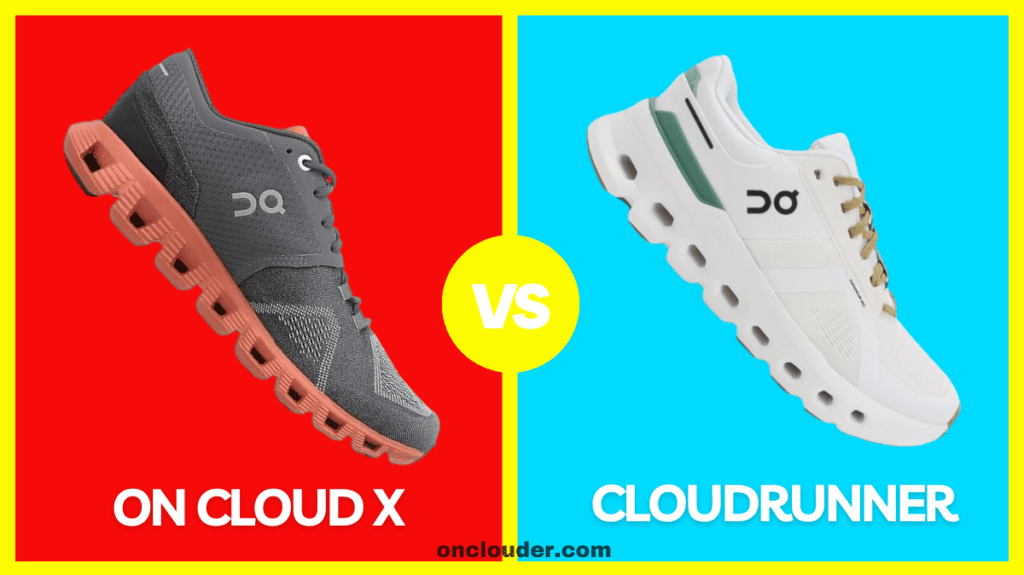
Contents
- 1 On Cloud X vs CloudRunner Shoes
- 2 Which Shoes Perfect for Any Activity
- 3 What Are On Cloud X and CloudRunner Shoes?
- 4 Comfort and Fit: Finding Your Perfect Match
- 5 Size Matters
- 6 Performance: How Do They Handle the Road?
- 7 Weight Matters
- 8 Durability: Built to Last?
- 9 Breathability: Keeping Your Feet Cool
- 10 Cushioning: Softness vs Responsiveness
- 11 Stability: Keeping You Steady
- 12 Quality and Materials: What Are They Made Of?
- 13 Style: Looking Good on the Run
- 14 Flexibility: Bending with Your Foot
- 15 Water Resistance: Handling Wet Conditions
- 16 Sole: Where the Rubber Meets the Road
- 17 User Reviews: What Do Runners Say?
- 18 Price Comparison: What’s Your Budget?
- 19 Pros and Cons
On Cloud X vs CloudRunner Shoes
The main difference between On Cloud X and CloudRunner shoes is their purpose. Cloud X is made for mixed sports and quick movements, while CloudRunner is designed for long-distance running.
Cloud X is lighter and more flexible, perfect for gym workouts and short runs. CloudRunner offers more cushioning and support for longer runs.
Now, let’s create a detailed comparison table for On Cloud X vs CloudRunner Shoes:
| Feature | On Cloud X | CloudRunner |
| Best for | Mixed sports, short runs | Long-distance running |
| Weight | Lighter | Heavier |
| Cushioning | Moderate | More cushioning |
| Flexibility | Very flexible | Less flexible |
| Support | Moderate support | More supportive |
| Price | Usually more expensive | Usually less expensive |
| Durability | Good for varied activities | Better for road running |
In summary: On Cloud X and CloudRunner are both great shoes, but they’re made for different things. Cloud X is better if you like doing many types of sports and quick exercises. CloudRunner is better if you want to run for a long time. Cloud X is lighter and bendier, while CloudRunner gives more cushioning and support.
Also Read: On Cloud X3 vs On Cloud 5
Which Shoes Perfect for Any Activity
For Running
On Cloud X Shoes
Made for mixed sports and short runs. It’s light and flexible, great for quick movements and gym workouts. The Cloud X gives you a bouncy feel and works well for different types of exercise, not just running.
CloudRunner Shoes
Built for long-distance running. It has more cushioning and support, perfect for people who like to run for a long time. The CloudRunner is comfy and helps protect your feet during long runs on roads.
For Walking
On Cloud X Shoes
Good for everyday walks. It’s very light and comfy, making it nice for walking around town or going to school. The Cloud X doesn’t look too sporty, so you can wear it with different clothes.
CloudRunner Shoes
While it’s mainly for running, it can be comfy for walking too. It has lots of cushioning, which feels nice when you walk. But it might look a bit too much like a running shoe for just walking around.
For Standing All Day
On Cloud X Shoes
Works well if you need to stand a lot, like at school or a part-time job. It’s comfy without looking big and clunky. The Cloud X can keep your feet feeling good even if you stand for hours.
CloudRunner Shoes
Gives great support for standing all day, especially on hard floors. Its special foam makes it super comfy for long periods on your feet. But it looks more like a sports shoe than the Cloud X, so it might not fit in everywhere.
What Are On Cloud X and CloudRunner Shoes?
Before we dive into the details, let’s get to know these shoes a bit better.
On Cloud X: The Versatile Performer
On Cloud X shoes are designed for various activities. They’re great for running, but you can also use them for gym workouts or casual wear. These shoes are known for being lightweight and responsive.
CloudRunner: The Comfort Champion
CloudRunner shoes, on the other hand, focus on providing maximum comfort for everyday runs. They offer more cushioning and support, making them ideal for longer distances and people who want a softer feel.
Now that we have a basic idea of each shoe, let’s compare them in different areas.
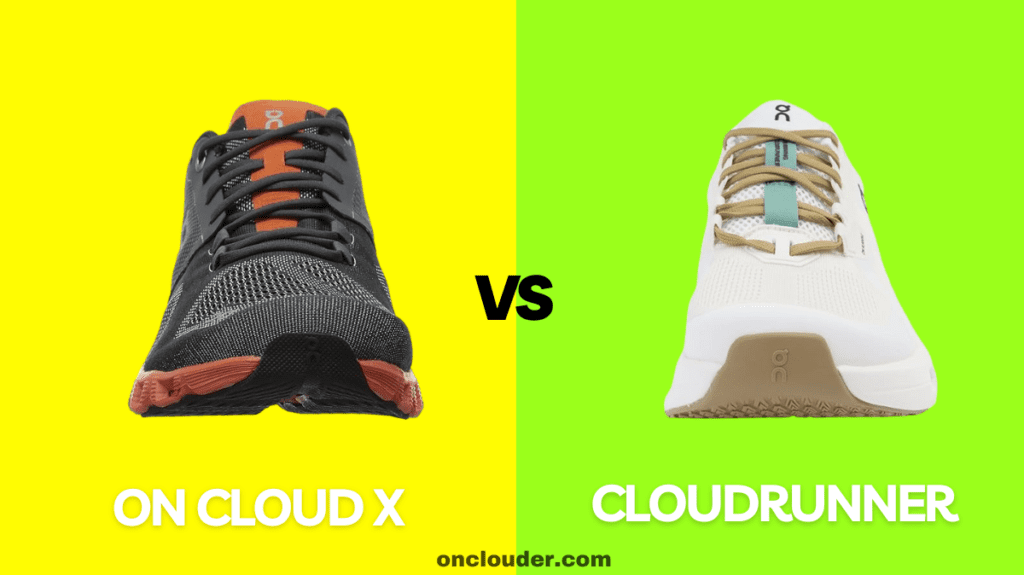
Comfort and Fit: Finding Your Perfect Match
When it comes to shoes, comfort is king. Let’s see how these two models stack up.
On Cloud X: Snug and Responsive
The On Cloud X offers a snug fit that feels like a second skin. It hugs your foot without being too tight. The shoe has a medium level of cushioning, which gives you a good feel of the ground while still protecting your feet.
CloudRunner: Plush and Supportive
CloudRunner shoes take comfort to the next level. They have more cushioning, which feels soft and bouncy. The fit is a bit roomier, especially in the toe box, which is great if you have wider feet or like some extra space.
Also Read: On Cloud X2 vs X3
Size Matters
Both shoes come in various sizes, but they might fit differently. Here’s a quick guide:
Size Comparison
| Aspect | On Cloud X | CloudRunner |
| Sizing | Runs slightly small | True to size |
| Width | Medium | Medium to Wide |
| Toe Box | Standard | Roomy |
Remember, everyone’s feet are different. It’s always best to try on shoes before buying if possible.
Performance: How Do They Handle the Road?
Now, let’s talk about how these shoes perform when you’re out for a run or at the gym.
On Cloud X: The Jack of All Trades
The On Cloud X shines in its versatility. Here’s what you can expect:
- Great for short to medium runs
- Responsive feel for speed workouts
- Stable enough for gym sessions
- Lightweight for quick movements
CloudRunner: The Distance Dreamer
CloudRunner is built for comfort over long distances. Its features include:
- Excellent cushioning for longer runs
- Stable ride for consistent performance
- Smooth transition from heel to toe
- Good energy return to keep you going
Weight Matters
The weight of your shoes can affect your performance. Let’s compare:
Table 2: Weight Comparison
| Shoe Model | Men’s (Size 9) | Women’s (Size 7) |
| On Cloud X | 8.47 oz (240g) | 7.05 oz (200g) |
| CloudRunner | 10.41 oz (295g) | 8.47 oz (240g) |
As you can see, the On Cloud X is lighter, which might make it feel faster for some runners.
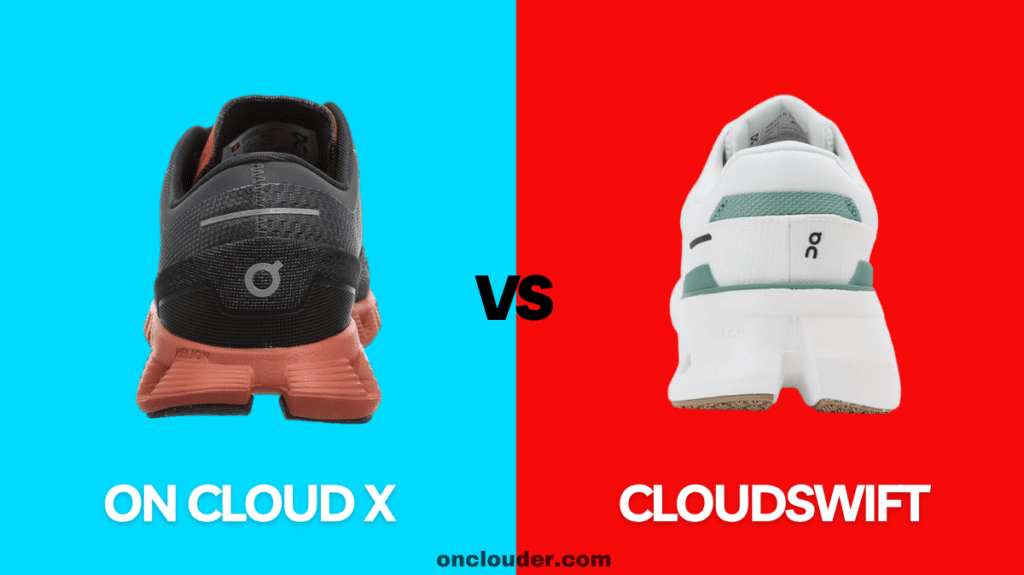
Durability: Built to Last?
When you buy running shoes, you want them to last. Let’s see how these shoes hold up over time.
On Cloud X: Tough but Light
The On Cloud X uses high-quality materials that can withstand regular use. The upper is made of a strong mesh that resists tearing. The outsole has rubber pads in high-wear areas to improve durability.
CloudRunner: Sturdy and Strong
CloudRunner shoes are built with durability in mind. They have a thicker sole and more robust construction. The outsole covers more area, which helps distribute wear more evenly.
Both shoes should last you several hundred miles of running, but the exact lifespan depends on how often you use them and your running style.
Also Read: On Cloud X vs Cloudswift
Breathability: Keeping Your Feet Cool
Nobody likes sweaty feet. Let’s see how these shoes handle airflow.
On Cloud X: Light and Airy
The On Cloud X has a thin, breathable upper made of engineered mesh. This allows air to flow freely, keeping your feet cool and dry during workouts.
CloudRunner: Balanced Ventilation
CloudRunner shoes also use a breathable mesh upper, but it’s slightly thicker for added support. While not as airy as the Cloud X, it still provides good ventilation for most runs.
Cushioning: Softness vs Responsiveness
The amount and type of cushioning in a shoe can greatly affect your running experience.
On Cloud X: Responsive Cushioning
The Cloud X uses On’s CloudTec cushioning system. It provides a medium level of softness with a responsive feel. This means you get some bounce back with each step, which can help you feel faster.
CloudRunner: Plush Comfort
CloudRunner takes cushioning up a notch. It has more CloudTec elements, creating a softer, more pillowy feel. This extra cushioning is great for absorbing impact on longer runs.
Cushioning Comparison
| Aspect | On Cloud X | CloudRunner |
| Cushion Level | Medium | High |
| Feel | Responsive | Soft |
| Best For | Speed, Agility | Comfort, Distance |
Stability: Keeping You Steady
Stability in a running shoe helps prevent your foot from rolling inward (overpronation) too much.
On Cloud X: Neutral Stability
The Cloud X is a neutral shoe, meaning it doesn’t have extra features to correct pronation. However, its snug fit and responsive cushioning provide a stable feel for most runners.
CloudRunner: Enhanced Stability
CloudRunner offers more stability features. It has a wider base and a supportive heel counter that helps keep your foot aligned. This makes it a good choice for runners who need a bit more support.
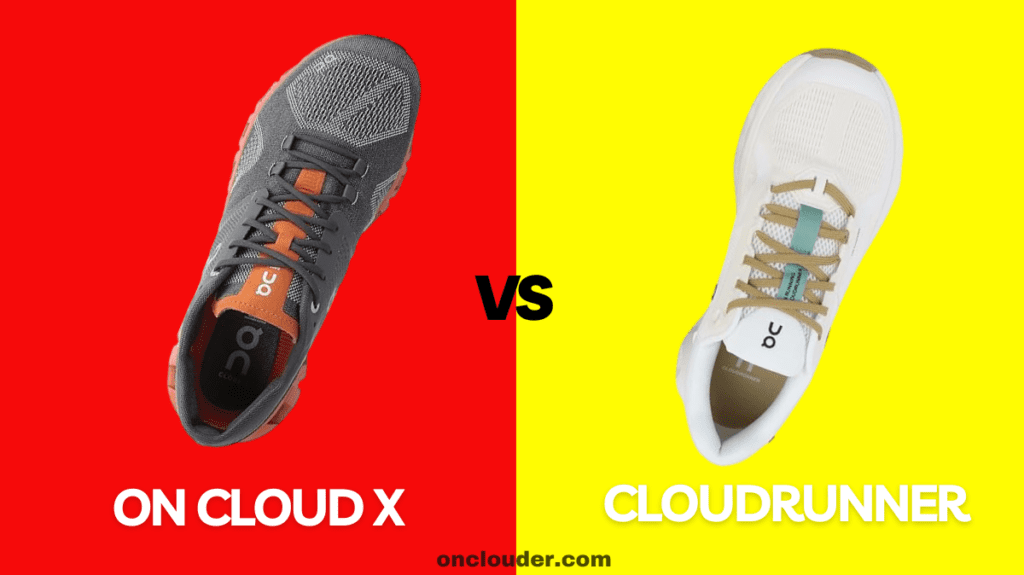
Quality and Materials: What Are They Made Of?
The materials used in a shoe affect its performance, durability, and comfort.
On Cloud X: High-Tech Materials
The Cloud X uses:
- Engineered mesh upper for breathability
- CloudTec cushioning made from Zero-Gravity foam
- Rubber pads on the outsole for traction
CloudRunner: Durable Construction
The CloudRunner features:
- Slightly thicker engineered mesh upper
- Helion superfoam for cushioning
- Full rubber outsole for durability
Both shoes use high-quality materials, but they’re designed for different purposes.
Style: Looking Good on the Run
While performance is crucial, many runners also care about how their shoes look.
On Cloud X: Sleek and Modern
The Cloud X has a streamlined, minimalist design. It comes in various color options, from subtle to bold. Its sleek look makes it suitable for both running and casual wear.
CloudRunner: Sporty and Supportive
CloudRunner has a more traditional running shoe look. It’s a bit bulkier due to the extra cushioning, but still attractive. It also comes in multiple color choices to suit different tastes.
Flexibility: Bending with Your Foot
A flexible shoe can help your foot move more naturally.
On Cloud X: Highly Flexible
The Cloud X is very flexible, allowing your foot to move freely. This is great for quick changes in direction and varied workouts.
CloudRunner: Moderate Flexibility
CloudRunner is less flexible due to its thicker sole and more supportive structure. However, it still bends enough for a smooth running experience.
Also Read: On Cloud X vs Nike Metcon
Water Resistance: Handling Wet Conditions
Sometimes you have to run in the rain. Here’s how these shoes handle moisture.
On Cloud X: Quick-Drying
While not waterproof, the Cloud X’s mesh upper dries quickly if it gets wet. The shoe doesn’t hold much water, which helps prevent your feet from getting soggy.
CloudRunner: Weather-Ready
CloudRunner has a slightly more water-resistant upper. It won’t keep your feet completely dry in heavy rain, but it handles light moisture well.
Sole: Where the Rubber Meets the Road
The sole of a running shoe is crucial for traction and cushioning.
On Cloud X: CloudTec Innovation
The Cloud X sole features On’s unique CloudTec elements – hollow pods that compress when you land and spring back when you push off. This design aims to provide cushioning and energy return.
CloudRunner: Cushioned Comfort
CloudRunner also uses CloudTec, but with larger elements for more cushioning. The outsole has more rubber coverage for better traction and durability.
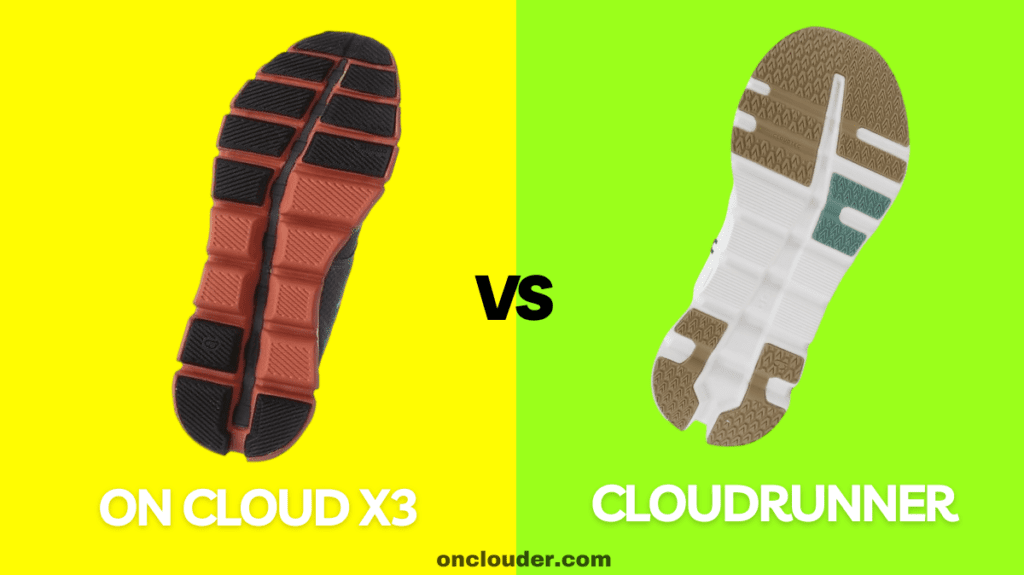
User Reviews: What Do Runners Say?
Let’s see what other runners think about these shoes.
| Shoe Model | Average Rating | Comments |
| On Cloud X | ⭐⭐⭐⭐½ (4.5/5) | “Versatile and comfortable” |
| “Great for gym and short runs” | ||
| “Fits like a glove” | ||
| CloudRunner | ⭐⭐⭐⭐ (4/5) | “So cushioned and comfy” |
| “Perfect for long runs” | ||
| “Helped with my knee pain” |
Price Comparison: What’s Your Budget?
Running shoes are an investment in your health and comfort. Here’s how these models compare in price:
| Shoe Model | Average Price (USD) |
| On Cloud X | $140 – $160 |
| CloudRunner | $140 – $150 |
Prices may vary depending on where you buy and any ongoing sales.
Pros and Cons
On Cloud X Shoes
Pros
- Great for many types of sports
- Very light and easy to move in
- Good for quick changes in direction
Cons
- Might not be comfy for very long runs
- Can be more expensive
- Might wear out faster if used for lots of running
CloudRunner
Pros
- Very comfy for long runs
- Gives lots of support to your feet
- Usually costs less than Cloud X
Cons
- Might feel too heavy for quick sports
- Not as bendy as Cloud X
- Not the best for gym workouts
In conclusion: After comparing On Cloud X and CloudRunner shoes, it’s clear that both are quality options, but they serve different needs.
Choose On Cloud X if:
- You want a versatile shoe for various activities
- You prefer a lighter, more responsive feel
- You do a mix of running and gym workouts
Choose CloudRunner if:
- You prioritize comfort for longer runs
- You need extra cushioning and support
- You want a shoe dedicated to road running
Remember, the best shoe for you depends on your individual needs, foot shape, and running style. If possible, try both on to see which feels better.
Are On Cloud X shoes good for long-distance running?
While On Cloud X shoes can handle longer runs, they’re best suited for short to medium distances. If you regularly run long distances, CloudRunner might be a better choice due to its extra cushioning.
Can I use CloudRunner shoes for gym workouts?
CloudRunner shoes are designed primarily for running. While you can use them in the gym, the On Cloud X might be a better option for varied workouts due to its versatility and lighter weight.
How often should I replace my On running shoes?
Generally, you should replace running shoes every 400-500 miles. However, this can vary based on your running style, body weight, and the surfaces you run on. Keep an eye on wear patterns and how the shoes feel – if they’re no longer comfortable or supportive, it’s time for a new pair.
Are these shoes good for people with wide feet?
CloudRunner tends to be better for wider feet due to its roomier toe box. On Cloud X has a snugger fit, which might not be as comfortable for those with wide feet.
Can I use these shoes if I have flat feet or high arches?
Both shoes can work for various foot types. However, if you have specific foot concerns like flat feet or high arches, it’s best to consult with a podiatrist or visit a specialty running store for personalized advice.




